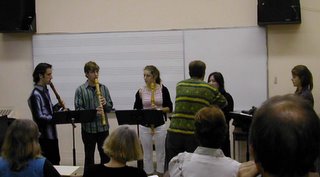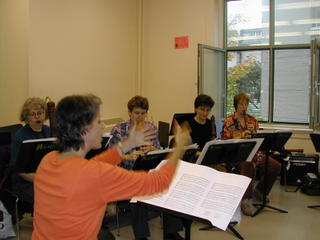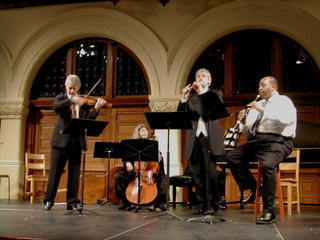Les Voix humaines - Violation
The lights dimmed and a drone, soon joined by a simple melody, began the concert, transporting us back through the centuries to medieval Spain. Eight viols filled the hall with their rich, mellow sounds. It was lovely to hear such a large ensemble. A lively rendition of Ortiz's Ricercada Secunda changed the mood. The lights got brighter and the rhythms got more complex.
This concert was dedicated to the memory of Peggie Sampson, a pioneer gamba player in Canada. Nine viola gamba players paid tribute to her legacy in a most fitting fashion.
Suzie Leblanc introduced "The Leaves be Green" with an a capella version of the tune prior to the Byrd version for 5 viols. This is a complex piece with the melody moving from voice to voice. It would have been nice to be able to follow the melody a bit more, but viols create quite a dense sound and do not always leave sound space for others. I love the lush sound of the viols and there were many lovely moments.
In the Dowland set, the lute and harpsicord provided good contrast to the viols - the plucked sound leaves more space between the notes. Suzie Leblanc always charms with her pure, clear voice.
Kuijken, as he did in the concert on the 19th demonstrated his virtuosity. He is a very lyrical player and in the Adagio section of the piece by Carl Friedrich Abel played exquisitely quietly, creating an amazing sense of intimacy.
The Cryes of London was fun to listen to . The viols played a lovely 4 part interchange. Over it, Suzie Leblanc sang a litany of the goods for sale in London. Suzie took on the voices of some of the characters who might have been selling items in 17th century London.
I was very impressed with Nan Mackie's playing in the Adaskin Adagio and Allegretto. The piece brought out different facets of the viol from the use of very high notes, to bowing and plucking at the same time, to changing the pitch while playing. The piece was sometimes a challenge to listen to, but I did find it interesting.
I particularly enjoyed the piece by Matthias Maute, Tell Me, True Love. The viols, at times meditative, at times energetic were overlaid with an interesting vocal part. I would love to hear it again, though I don't know when I will have the chance to hear so many viols together in one concert again!
This concert was dedicated to the memory of Peggie Sampson, a pioneer gamba player in Canada. Nine viola gamba players paid tribute to her legacy in a most fitting fashion.
Suzie Leblanc introduced "The Leaves be Green" with an a capella version of the tune prior to the Byrd version for 5 viols. This is a complex piece with the melody moving from voice to voice. It would have been nice to be able to follow the melody a bit more, but viols create quite a dense sound and do not always leave sound space for others. I love the lush sound of the viols and there were many lovely moments.
In the Dowland set, the lute and harpsicord provided good contrast to the viols - the plucked sound leaves more space between the notes. Suzie Leblanc always charms with her pure, clear voice.
Kuijken, as he did in the concert on the 19th demonstrated his virtuosity. He is a very lyrical player and in the Adagio section of the piece by Carl Friedrich Abel played exquisitely quietly, creating an amazing sense of intimacy.
The Cryes of London was fun to listen to . The viols played a lovely 4 part interchange. Over it, Suzie Leblanc sang a litany of the goods for sale in London. Suzie took on the voices of some of the characters who might have been selling items in 17th century London.
I was very impressed with Nan Mackie's playing in the Adaskin Adagio and Allegretto. The piece brought out different facets of the viol from the use of very high notes, to bowing and plucking at the same time, to changing the pitch while playing. The piece was sometimes a challenge to listen to, but I did find it interesting.
I particularly enjoyed the piece by Matthias Maute, Tell Me, True Love. The viols, at times meditative, at times energetic were overlaid with an interesting vocal part. I would love to hear it again, though I don't know when I will have the chance to hear so many viols together in one concert again!







